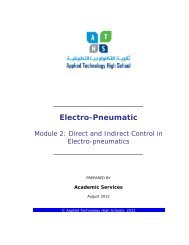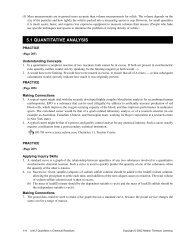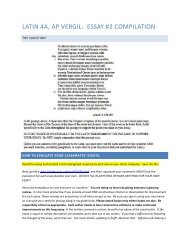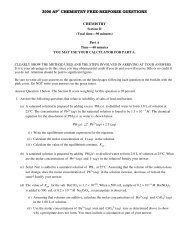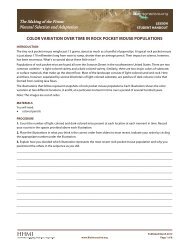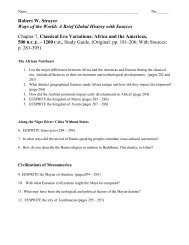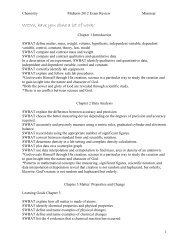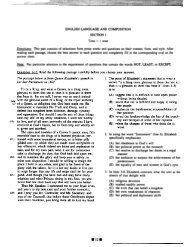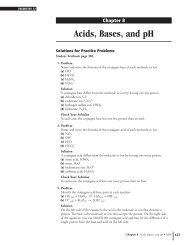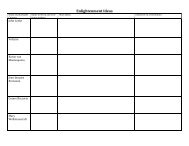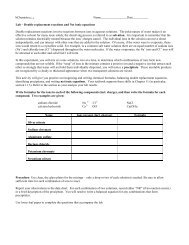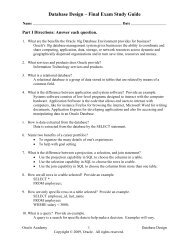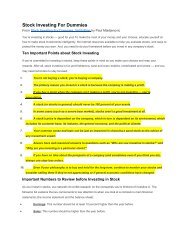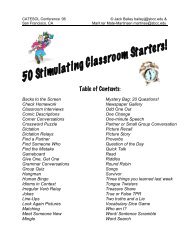You also want an ePaper? Increase the reach of your titles
YUMPU automatically turns print PDFs into web optimized ePapers that Google loves.
Name____________________________________________________________<br />
Per.______<br />
Robert W. Strayer<br />
Ways of the World: A Brief Global History with Sources<br />
<strong>Chapter</strong> <strong>14</strong>, <strong>Study</strong> <strong>Guide</strong>, Empires and Encounters, <strong>14</strong>50-1750 <strong>Study</strong> <strong>Guide</strong> pp. 625-650<br />
European Empires in the Americas<br />
1. What initiated early Western European Empires to expand? What role did geography play?<br />
2. Why did the European merchant class seek direct access to Asian wealth?<br />
3. As population sharply diminished in the Americas, what did the “great dying” create?<br />
4. The silver mines in Mexico and Peru allowed the Spanish conquerors and other Europeans to buy massive<br />
amounts of what highly valuable commodities?<br />
5. What was the Columbian Exchange?<br />
Comparing Colonial Societies in the Americas<br />
6. Explain the theory of mercantilism.<br />
7. What three kinds of economy were established by the new colonial societies among Native American<br />
cultures?<br />
8. What was the economic foundation of colonial rule in Mexico and Peru? Who provided the labor?<br />
9. Draw a diagram of this social hierarchy and elaborate on the class structure.<br />
10. What happened to Native Americans’ religious beliefs in Mesoamerica and Peru when confronted with<br />
Catholicism?<br />
11. How did the plantation societies of Brazil and Caribbean differ from those of southern colonies in British<br />
North America? (Think economies, labor, and social standing.<br />
The Steppes and Siberia: The Making of a Russian Empire<br />
12. Who were the Cossacks?<br />
13. Compared to the Western Europeans, explain how the Russians acquired their empire.
Asian Empires<br />
<strong>14</strong>. What were the major features of Chinese empire building in the early modern era of the 17 th and 18 th<br />
centuries?<br />
15. How did Mughal attitudes and policies toward Hindus change from the time of Akbar to that of Aurangzeb?<br />
16. What was the century-long conflict between the Ottomans and the Safavids?<br />
17. Why was Byzantium no longer the “heir to the glory of Rome?”<br />
18. What were some of the ways that Christians had welcomed Ottoman conquest?<br />
19. In what other ways did Turkish rule bare heavily on Christians?<br />
20. What was the outcome of the Ottoman Siege of Vienna in 1683<br />
________1. The racial system of which of the<br />
following regions was characterized by less racial<br />
mixing and less willingness to recognize the offspring<br />
of interracial unions than the other regions?<br />
(A) Brazil<br />
(B) British North America<br />
(C) The Caribbean<br />
(D) Mexico<br />
________2. Which of the following is a reason why<br />
Portugal, Spain, France, and Britain were the<br />
first to expand into the New World?<br />
(A) These lands had a long tradition<br />
of distant exploration.<br />
(B) These lands were Muslim.<br />
(C) These lands were on the<br />
Atlantic coast.<br />
(D) These lands believed in ancient<br />
legends of a lost world across the ocean.<br />
________3. The Spanish Empire in former Aztec and<br />
Inca lands<br />
(A) relied primarily on the import of<br />
African slaves for labor.<br />
(B) failed to set up an elaborate<br />
administrative bureaucracy.<br />
(C) possessed an economy based on<br />
commercial agriculture and mining.<br />
(D) possessed strict social<br />
boundaries between races which made mixed<br />
race people rare.<br />
________4. What happened to Native Americans’<br />
religious beliefs in Mesoamerica and Peru when<br />
confronted with Catholicism?<br />
(A) They rejected Catholicism<br />
completely.<br />
(B) They blended their old customs<br />
easily into Catholic practices.<br />
(C) They only pretended to be<br />
Catholic when Europeans were around.<br />
(D) They completely abandoned<br />
their old religions, and embraced Catholicism<br />
entirely.<br />
________5. Which of the following statements about<br />
the systems of slavery in Brazil and British<br />
North<br />
America is true?<br />
(A) The importation of slaves ended<br />
earlier in Brazil than in North America.<br />
(B) More slaves were voluntarily set<br />
free by their owners in Brazil than in North<br />
America.<br />
(C) Slaves in Brazil had longer<br />
working lives on average and became selfreproducing<br />
after 1750.<br />
(D) Only slaves in North America<br />
worked on plantations.
________6. The British colonies and the<br />
Portuguese/Spanish colonies in the Americas<br />
differed in that<br />
(A) more mixed-race families<br />
emerged in the British colonies.<br />
(B) Spanish colonists were far more<br />
numerous than British colonists.<br />
(C) the British colonists sought to<br />
escape European traditions, while<br />
Spanish/Portuguese colonists sought to recreate<br />
them.<br />
(D) the British colonization began a<br />
full 100 years before the Spanish/Portuguese<br />
colonization.<br />
________7. What is one major reason for the higher<br />
literacy rates in British colonies than in<br />
Spanish/Portuguese colonies?<br />
(A) Protestantism, which encouraged<br />
reading the Bible, was the dominant form of<br />
Christianity in the British colonies.<br />
(B) Paper was harder to maintain in the<br />
warm, humid Spanish/Portuguese colonies.<br />
(C) The British government invested<br />
massive funds into building libraries throughout<br />
North America.<br />
(D) Spanish/Portuguese colonizers did<br />
not attempt to teach Native Americans to speak<br />
or read Spanish/Portuguese.<br />
________8. Which of the following was a feature of<br />
China’s rule over its newly acquired Central<br />
Asian territories that made the region more a<br />
separate part of its empire rather unified with the<br />
core of China?<br />
(A) A massive inflow of Chinese<br />
settlers<br />
(B) A concerted effort to assimilate the<br />
local populations into Chinese society<br />
(C) Genocide<br />
(D) The creation of a new office called<br />
the Court of Colonial Affairs<br />
________9. What was the consequence of the<br />
expansion of the Chinese and Russian Empires<br />
on the nomadic peoples of Central Asia?<br />
(A The political independence and<br />
economic prosperity of nomadic peoples came<br />
to an end.<br />
(B) The local religious customs and<br />
languages were completely erased, replaced<br />
entirely by the customs of the conquerors.<br />
(C) A brief economic boom ensued,<br />
which encouraged many nomads to move to<br />
cities and buy houses.<br />
(D)They felt little impact; as long as<br />
they paid tribute, the nomadic peoples were<br />
mostly left alone.<br />
________10. Akbar’s policy toward the Hindus of India<br />
is best described as<br />
(A) extermination.<br />
(B) religious tolerance and<br />
incorporation of Hindu elites.<br />
(C) massive efforts to convert Hindus to<br />
Islam.<br />
(D) holy war against Hindus.<br />
Make sure the following empires are labeled and shaded on your world map and included on your timeline.<br />
Include the years each ruled.<br />
1. Spanish Empire in the Americas<br />
2. British colonies in the Americas<br />
3. Rule of Peter the Great and Catherin the<br />
Great of Russia<br />
4. Ming Dynasty of China<br />
5. Qing Dynasty of China<br />
6. Mughal Dynasty of India<br />
7. Ottoman Empire<br />
8. Safavid Empire<br />
9. Habsburg Empire of Europe (map only)<br />
10. England (map only)<br />
11. France (map only)<br />
12. Spain (map only)<br />
13. Portugal (map only)



